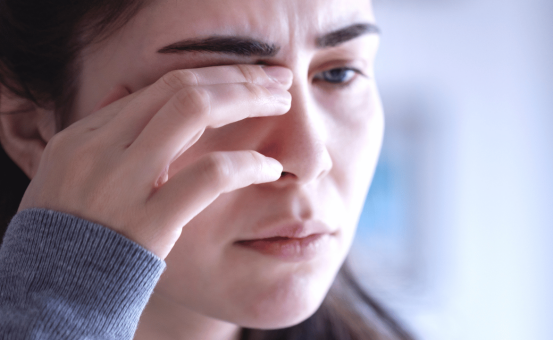Thyroid Eye Disease (TED) is a serious eye condition, yet it’s often mistaken for more common eye issues like allergies, conjunctivitis, or dry eye. Early recognition of TED can make a significant difference, as symptoms tend to progress over time. This article outlines sneaky symptoms of TED to help identify the condition, along with information on its prevalence and factors that may increase the risk.

Common Signs and Symptoms of Thyroid Eye Disease (TED)
TED symptoms can range from mild irritation to more severe changes that affect vision. Below are common signs to watch for:
- Bulging Eyes (Proptosis):One of the hallmark symptoms, proptosis, occurs when the eyes appear to bulge or protrude due to inflammation and tissue expansion around the eye socket. This symptom is often gradual and may go unnoticed initially.
- Dryness and Irritation: Many with TED experience dryness, redness, and discomfort, resembling common dry eye disease. However, typical over-the-counter remedies may offer limited relief.
- Eyelid Swelling or Retraction:Swollen or retracted eyelids are prevalent in TED, giving the eyes a “staring” appearance, which can be mistaken for allergies or conjunctivitis.
- Double Vision (Diplopia): Muscle swelling behind the eyes may result in double vision, especially when looking in certain directions. TED-related diplopia tends to worsen over time if not addressed.
- Pressure or Pain in the Eyes: Persistent feelings of pressure, discomfort, or even pain around the eyes are common, particularly during moments of movement or strain.
- Sensitivity to Light (Photophobia): Eye inflammation in TED can lead to heightened sensitivity to light, a symptom often mistaken for migraines or other conditions.
- Difficulty Moving Eyes: Reduced mobility, or restrictive myopathy, can occur as eye muscles swell and stiffen. Patients may struggle to look in specific directions without experiencing discomfort or double vision.
Each of these symptoms can vary in intensity, and some may be sneaky or subtle at first, making the progression of TED unique to each individual. Consulting an eye care specialist is advisable if any combination of these symptoms persists.
Thyroid Eye Disease May Be More Common Than You Think
While TED may seem like a rare condition, it is actually relatively common among individuals with thyroid disorders. Studies show that TED affects around 50% of patients with thyroid disease within the Caucasian population. For the general population in the U.S., the annual incidence rate is approximately 16.0 per 100,000 for females and 2.9 per 100,000 for males (Source: National Library of Medicine).
TED tends to show a bimodal peak incidence pattern, with peak ages of 40 to 44 and 60 to 64 years in females, and 45 to 49 and 65 to 69 years in males. Older patients may face more severe cases with increased risks for restrictive myopathy and dysthyroid optic neuropathy (DON) (Source: National Library of Medicine).
Environmental Factors: Smoking has a strong correlation with TED, as it is thought to exacerbate symptoms and increase the likelihood of developing the disease. Managing environmental factors like smoking cessation may lower TED risks and help improve outcomes.
Available Treatment Options for Thyroid Eye Disease (TED)
The primary treatment for Thyroid Eye Disease (TED) depends on the severity of symptoms. One of the most effective options is Tepezza (Teprotumumab), a medication specifically designed for TED. Tepezza targets the proteins causing inflammation and tissue swelling in the eyes. It helps reduce symptoms like bulging eyes and double vision and has shown significant results in improving appearance and vision (Source: Tepezza).
For milder cases, lubricating eye drops or sunglasses can provide relief from dryness and light sensitivity. Surgery, such as orbital decompression, may be needed for severe cases to protect vision (Source: Thyroid Eyes).
Final Thoughts
Recognizing the signs of TED can help guide early intervention, potentially preventing the condition from advancing. Awareness of TED’s prevalence and associated risk factors empowers individuals to seek specialized care promptly. If you or someone you know experiences persistent eye symptoms or has a history of thyroid disorders, consider consulting with an eye care professional for further evaluation.





